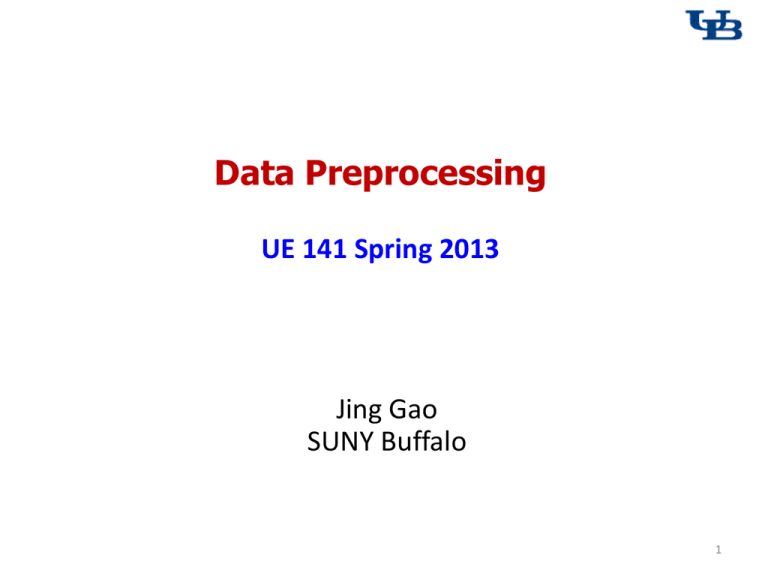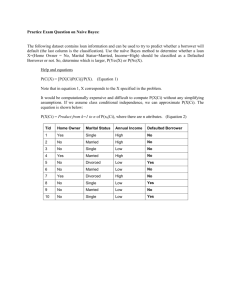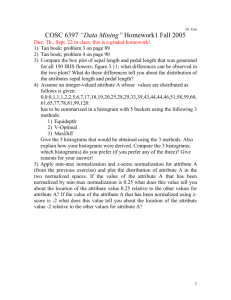Data Preprocessing UE 141 Spring 2013 Jing Gao
advertisement

Data Preprocessing UE 141 Spring 2013 Jing Gao SUNY Buffalo 1 Outline • Data • Data Preprocessing – Improve data quality – Prepare data for analysis • Exploring Data – Statistics – Visualization 2 Document Data • Each document is a collection of words 3 Transaction Data • A collection of transactions – Each transaction involves a set of items TID Items 1 Bread, Coke, Milk 2 3 4 5 Beer, Bread Beer, Coke, Diaper, Milk Beer, Bread, Diaper, Milk Coke, Diaper, Milk 4 Graph Data Aspirin Internet Yeast protein interaction network Co-author network 5 Sequence Data • DNA Sequence GGTTCCGCCTTCAGCCCCGCGCC CGCAGGGCCCGCCCCGCGCCGTC GAGAAGGGCCCGCCTGGCGGGCG GGGGGAGGCGGGGCCGCCCGAGC CCAACCGAGTCCGACCAGGTGCC CCCTCTGCTCGGCCTAGACCTGA GCTCATTAGGCGGCAGCGGACAG GCCAAGTAGAACACGCGAAGCGC TGGGCTGCCTGCTGCGACCAGGG 6 Spatial-Temporal Data Average Monthly Temperature of land and ocean 7 Record Data • Data that consists of a collection of records, each of which consists of a fixed set of attributes Tid Refund Marital Status Taxable Income Cheat 1 Yes Single 125K No 2 No Married 100K No 3 No Single 70K No 4 Yes Married 120K No 5 No Divorced 95K Yes 6 No Married No 7 Yes Divorced 220K No 8 No Single 85K Yes 9 No Married 75K No 10 No Single 90K Yes 60K 10 8 Record Data • Collection of data objects and their attributes Attributes • An attribute is a property or characteristic of an object – Examples: eye color of a person, temperature, etc. – Attribute is also known as variable, field, characteristic, or feature Tid Refund Marital Status Objects • A collection of attributes describe an object – Object is also known as record, point, case, sample, entity, or instance Taxable Income Cheat 1 Yes Single 125K No 2 No Married 100K No 3 No Single 70K No 4 Yes Married 120K No 5 No Divorced 95K 6 No Married 7 Yes Divorced 220K 8 No Single 85K Yes 9 No Married 75K No 10 No Single 90K Yes 60K Yes No No 10 9 Types of Attribute • Categorical Attribute – Has only a finite or countably infinite set of values – Examples: zip codes, weather conditions, or the set of words in a collection of documents • Numerical Attribute – Has real numbers as attribute values – Examples: temperature, height, or weight 10 Outline • Data • Data Preprocessing – Improve data quality – Prepare data for analysis • Exploring Data – Statistics – Visualization 11 Data Quality Issue • Data in the real world is dirty – incomplete: lacking attribute values, lacking certain attributes of interest • e.g., occupation=“ ” (missing data) – noisy: containing noise, errors, or outliers • e.g., Salary=“−10” (an error) – inconsistent: containing discrepancies in codes or names, e.g., • Age=“42” Birthday=“03/07/1997” • Was rating “1,2,3”, now rating “A, B, C” • discrepancy between duplicate records 12 Preprocessing • Handle missing values – Ignore the records with missing values – Estimate missing values • Remove outliers – Find and remove those values that are significantly different from the others • Resolve conflicts – Merge information from different data sources – Find duplicate records and identify the correct information 13 Prepare Data for Analysis • • • • Sampling Feature selection Dimensionality reduction Discretization 14 Sampling • Goal – Extract a subset of records so that the selected records are representative of original data 8000 points 2000 Points 500 Points 15 Attribute Selection • Redundant attributes – duplicate much or all of the information contained in one or more other attributes – Example: purchase price of a product and the amount of sales tax paid • Irrelevant attributes – contain no information that is useful for the data mining task at hand – Example: students' ID is often irrelevant to the task of predicting students' GPA 16 Dimensionality Reduction • Goal is to reduce the number of attributes by creating a new set of attributes x2 e x1 17 Discretization • Binning – Convert numerical data into categorical data – Divides the range into N intervals q Sorted data for price (in dollars): 4, 8, 9, 15, 21, 21, 24, 25, 26, 28, 29, 34 * Partition into 3 bins: - Bin 1: 4, 8, 9, 15 - Bin 2: 21, 21, 24, 25 - Bin 3: 26, 28, 29, 34 18 Outline • Data • Data Preprocessing – Improve data quality – Prepare data for analysis • Exploring Data – Statistics – Visualization 19 Statistics: Center Measurement Center measurement is a summary measure of the overall level of a dataset Mean: Summing up all the observation and dividing by number of observations. Mean of 20, 30, 40 is (20+30+40)/3 = 30. Notation : Let x1 , x2, ...xn are n observations of a variable x. Then the mean of this variable, n x1 + x2 + ... + xn = x= n åx i =1 i n 20 Statistics: Variability Measurement Variance: The variance of a set of observations is the average of the squares of the deviations of the observations from their mean. In symbols, the variance of the n observations x1, x2,…xn is ( x1 - x ) 2 + .... + ( xn - x ) 2 S = n -1 2 Variance of 5, 7, 3? Mean is (5+7+3)/3 = 5 and the variance is (5 - 5) 2 + (3 - 5) 2 + (7 - 5) 2 =4 3 -1 Standard Deviation: Square root of the variance. The standard deviation of the above example is 2. 21 Statistics: Frequency Distribution Consider a data set of 26 children of ages 1-6 years. Then the frequency distribution of variable ‘age’ can be tabulated as follows: Frequency Distribution of Age Age 1 2 3 4 5 6 Frequency 5 3 7 5 4 2 Grouped Frequency Distribution of Age: Age Group 1-2 3-4 5-6 Frequency 8 12 6 22 Question • Data Visualization – Choose a few creative and fascinating examples of data visualization to show to the class http://selection.datavisualization.ch/ 23







